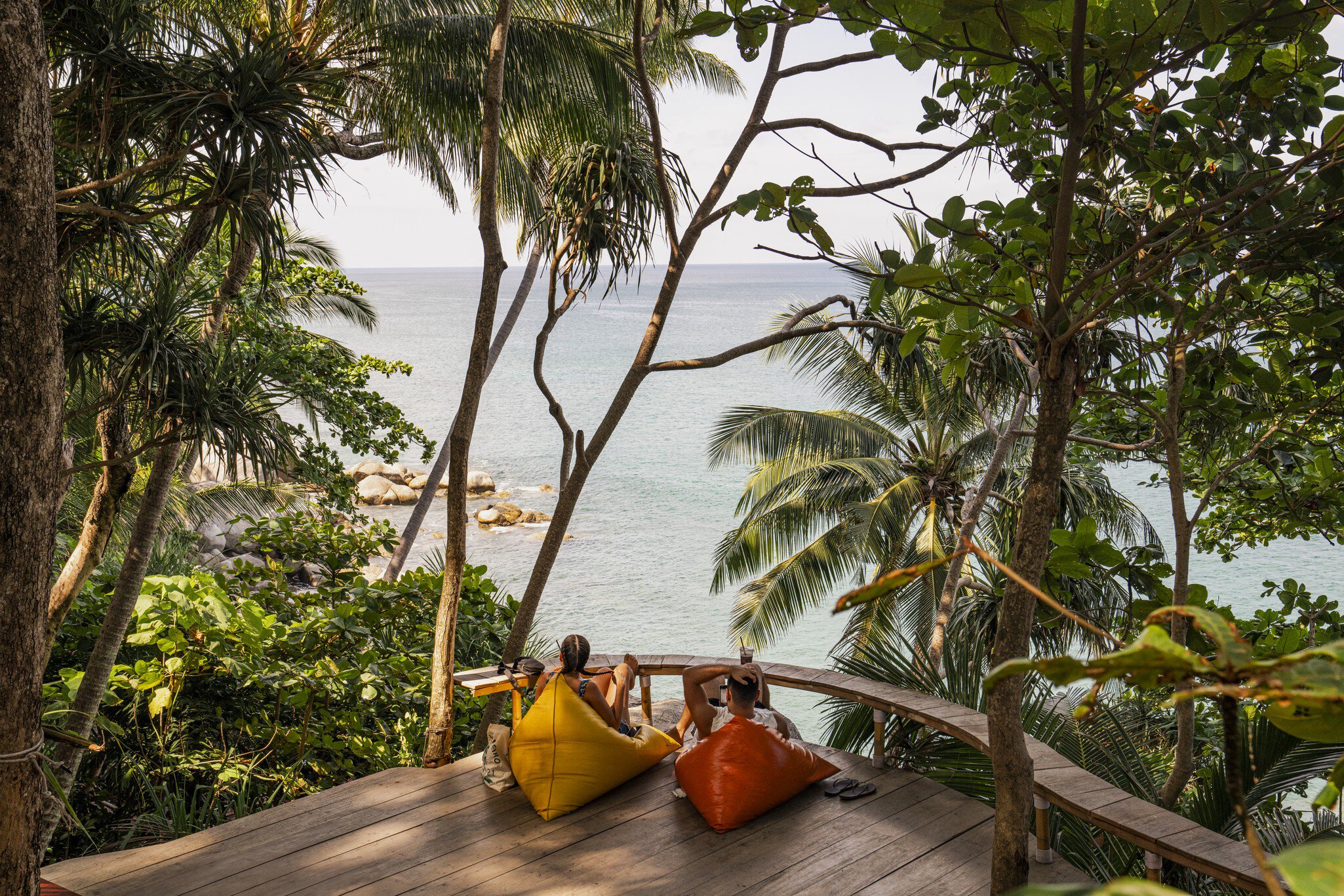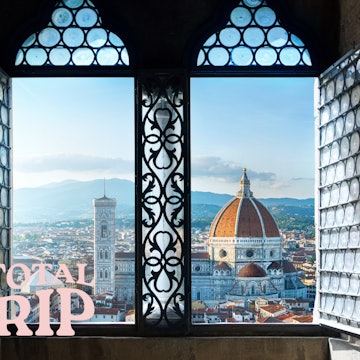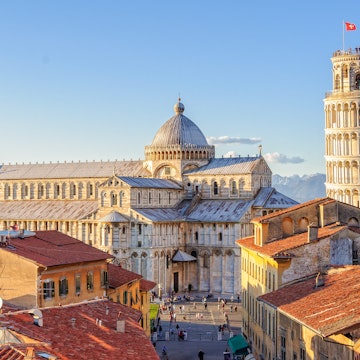

The Galleria degli Uffizi and Ponte Vecchio in Florence. ValerioMei/Getty Images
Certain cities are one giant outdoor museum. Florence is one of them. Simply walking around Italy’s greatest Renaissance city reveals an unparalleled treasure chest of public art and architecture to rival the finest Botticelli. Then, of course, there are the specimens and curiosities thrown up by this over-touristed city’s kaleidoscopic crowds: the Medici family’s world-renowned curiosity cabinets aren’t a patch on some of the mesmerizing sights, sounds and spectacles you get to enjoy pretty much any time of year these days in Florence’s living street museum.
When the sensory onslaught of statues, sculptures and monuments littering every second piazza, street corner and city bridge in the centro storico (historic center) gets too much, seek peace and quiet contemplation behind closed doors. Here are the city's best museums to duck into. From world-renowned celebrity to niche, each is eye-opening in its own unique or gruesome way.

1. Galleria degli Uffizi
Best for Italian Renaissance art
A Florentine rite of passage since 1769, you really can’t skip this prestigious art museum. Lapping up the energizing vibe – buskers, mime artists, singers, selfie-wheeling tourists – in the elongated courtyard by the entrance is as much part of the experience as getting lost in the 16th-century palace’s gargantuan maze of 100-odd rooms. For those that aren’t massive art fans, the gallery also squirrels away fun stuff like the Tribune encrusted with 5780 Indian ocean mother of pearls (16th-century interior decorators used millions of crushed cochineal insects to make the scarlet wall varnish) or the Math Room, where Grand Duke Ferdinando I de' Medici stashed war-machine models, maps and other innovative hi-tech of the day. The Uffizi art collection spans Ancient Greece to 18th-century Venice, but its USP is the world’s largest collection of Italian Renaissance art.
Planning tip: Buy a good-value Passepartout, valid five consecutive days, to also get into the Boboli gardens, Palazzo Pitti and (for a few euros more) the emblematic Corridoio Vasariano, open again at last after an eight-year hiatus.

2. Museo dell’Opera del Duomo
Best place to learn about Florence's iconic cathedral
No museum provides such rich insight and vital background into Florence’s celebrity cathedral complex comprising the Duomo with Brunelleschi’s flame-red cupola (don’t miss the climb inside), standalone campanile (bell tower) and baptistery. The awe-inspiring story is told through a mesmerizing collection of priceless sacred and liturgical treasures – this is as much a showcase of extraordinary Florentine craftsmanship as a history lesson.
Just in case you haven't already glimpsed it from every angle while mooching around Florence’s centro historico, a spectacular life-sized reconstruction of the cathedral’s original facade, ripped down in the 16th century, looms large in the museum’s main hall. The restored, 14th- and 15th-century gilded-bronze doors from the baptistery, carved in mind-blowing detail to illustrate biblical tales, are breathtaking. Further in the museum, Michelangelo's powerfully emotive La Pièta – sculpted when he was almost 80 and intended for his own tomb – is a heartbreaker.
3. Museo Volloresi
Best for artisan craftsmanship
Adding a heady note to any museum day, the Museo Villoresi explores the world of artisanal perfumery with interactive digital exhibits, olfactory booths, short films and a scent library. Intimate tours (book in advance online) end in a gloriously sweet-smelling terrace garden, perfumed with 80 different types of aromatic plants, trees and herbs – lemons, bergamot, yuzu, roses, jasmine, frangipane, laurel, olive, cypress and iris. The museum is at home in the 15th-century family palazzo (mansion) of revered Florentine perfumer Lorenzo Villoresi whose bespoke fragrances evoke the Tuscan countryside, garden and seaside.
Planning tip: To smell orange blossom, citrus, green laurel and bergamot long after you’ve left Florence, buy a vintage-styled glass vaporizer in the adjoining boutique.Can’t pick which scent? Go for an inspired "discovery set" containing four or six 2mL vials.

4. Palazzo Strozzi
Best for families
Whether you have art-curious kids or not, the attention-grabbing contemporary art at Renaissance Palazzo Strozzi captures everyone’s interest. Themed hands-on workshops and tours aimed squarely at families accompany each blockbuster exhibition: immersive games, activities and imaginative narratives plunge families into the vibrant world of Jeff Koons, modern American artists, contemporary French artist JR, all sorts. Two or three exhibitions usually run simultaneously.
Strozzi’s 15th-century interior courtyard is a buzzy spot to linger with locals and Strozzi Bistrò beneath its arches is an elegant spot for coffee (try the iced cappuccino), Tuscan wine and cocktail-fueled aperitivi (pre-dinner drinks).
Planning tip: Aim for Thursday when late-night opening at the museum adds extra oomph. The courtyard also has tip-top free wi-fi.
5. Manifattura Tabacchi
Best contemporary arts space
Convention flies out the window at this contemporary arts center, an ongoing urban regeneration project inside a 1930s tobacco-processing plant and cigarette factory near the central city park. Counter-culture art, fashion and design exhibitions held in this former industrial complex and vibrant new district are a brilliant antithesis of anything you’ll ever see in Florence’s traditional centro historico; pockets could be a street-art museum.
Of the dozen-plus hangars already restored, central hub the Factory is the place to be. Catch provocative art exhibitions, crafts workshops led by resident creatives, weekly yoga classes, vintage markets, pop-up coffee shops, one of Italy’s most talented tattoo artists at Noa Ink, among others. Leave Florence’s trademark crowds well behind in the Officina Botanica hanging rooftop garden. Architecture buffs, note: the complex is a sensational example of Italian Rationalist architecture and free guided tours of Le Caveau take you deep into the vintage bowels, history and heritage of the former factory.

6. Galleria dell’Accademia
Best celebrity nudes
It appears that standing in line for a very long time is one of the top things to do in Florence: a queue halfway down the street invariably marks the entrance to Galleria dell’Accademia, a gallery purpose-built in 1784 to house the world’s most famous nude. Fortunately, ANY wait is worth it; buy tickets online to cut wait times. Michelangelo sculpted David from a single block of marble in 1501–04 and the subtle detail – the veins in his sinewy arms, the leg muscles, the change in expression as you pace around the statue – is impossibly bewitching.
Closeup, there is no denying the nude boy-warrior's incongruously large head and hands, and small penis. The 5.2m-tall sculpture (17ft) was originally intended to stand up high on a cathedral buttress in the apse, from where his head and hands would have appeared in perfect proportion. Why the small penis? In classical art a large or even normal-sized packet was not deemed elegant, hence the daintier size. Michelangelo’s unfinished Prigoni (Prisoners; 1519–34) are other nudes worth contemplation.
7. Museo delle Cappelle Medicee
Best for Medici bling
For serious glitzy razzle-dazzle hit the Medici Chapels Museum, the burial place of the Medici dynasty since 1429. So excessive is the Medici bling, it’s hard not to ogle in disbelief at the conceited riot of polychrome marbles, granite and glittering semi-precious stones adorning the funerary tombs in the mausoleum and crypts. No less than 49 dynasty members are buried here, a trio of which slumber in the shadow of haunting, voluptuous funerary sculptures depicting Dawn and Dusk, Night and Day and Madonna and Child by Renaissance maestro Michelangelo.
Planning tip: Save euros by investing in the 72hr-combo ticket covering entry to the Cappelle Medicee, Museo del Bargello, Museo di Palazzo Davanzati, Casa Martelli and unusual church-turned-grain market Chiesa e Museo di Orsanmichele.

8. La Specola
Best for weird and wonderful creatures
The unnervingly ghoulish, faithful wax reproductions of various human organs and body parts at La Specola won’t be everyone’s cup of tea. But for those who can stomach an unskinned corpse or wax lung in bad health, this section of Florence’s natural history museum from 1775 paints a riveting portrait of art and science in the 18th and 19th centuries. Waxworks were made from beeswax, dyed various shades of amber with gold powder, and used to teach young doctors.
Planning tip: To ensure no nasty surprises, you can only admire the anatomical models on a guided tour. Otherwise, you can freely meander hall after hall bursting with wooden cabinets of glittering topaz crystals and precious minerals, exquisite wax models of fruits and plants, stuffed exotic animals that once entertained the Medici family (look for Cosimo III’s pet hippo), all sorts. The waxwork artistry alone is incredible.
9. Museo degli Innocenti
Best for post-museum drinks
It’s impossible for your curiosity not to be piqued by the shiny sky-blue, glazed-terracotta medallions of swaddled babies peppering the facade of Florence’s former Ospedale degli Innocenti. The round arches and Roman capitals designed by Brunelleschi (yes, of cathedral cupola fame) in 1421 make this the first Renaissance building in Florence. Inside, state-of-the-art museum exhibits bring to life the moving tale of Florence’s foundling hospital – and later Europe's first orphanage – where unwanted children were cared for from 1421 until 1875.
End with coffee or aperitivo as the sun turns the city pink on the gorgeous wraparound panoramic terrace of rooftop museum cafe Caffé del Verone. Washed linen used to hang to dry on the clandestine deck, once the hospital’s verone (drying room).















